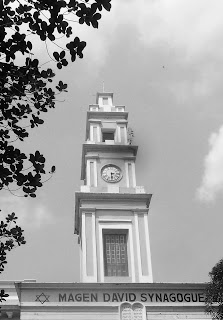In the late 1700's and early 1800's, Jews from Iraq began arriving in Calcutta and Mumbai.
It was not the first time Arabic speaking Jews had made their presence felt in India. The Great Mughal Akbar had a Jew in his court, and so did some subsequent Mughal emperors. Surat was one of the major ports of the Mughal empire, and Jewish merchants were well-established there, trading with the British East India Company.
As Mumbai prospered in the 1800's, Jews from Iraq, Syria, Afghanistan and Yemen began arriving in Mumbai in significant numbers. A lot of them came from Iraq, and so they were called Baghdadi Jews.
There was already another Jewish community in Mumbai, the Bene-Israel (Children of Israel). Believed to be one of the "ten lost tribes" of Israel, they had been in India for many centuries. The Bene-Israel were quite different from the Baghdadis - they spoke Marathi, and looked more Indian than Middle-Eastern. After many centuries in Maharashtra, Bene-Israeli cuisine had become localised, while the Baghdadi Jews followed their own cuisine. The prayer rituals of the Bene-Israel were also different from those of the Baghdadis. The two communities therefore, maintained a cultural distance, and did not intermarry.
In the initial years, the Baghdadis were few in number, and they prayed at the synagogues of the Bene Israeli community. But as their numbers grew, they began to want their own synagogue in Mumbai.
Two factors made this dream a possibility. The first was the arrival of the wealthy Sassoon family of Baghdadi Jews in 1832. The second was the opening of the opium trade in the 1840's which allowed the Sassoons to amass huge fortunes. As their wealth multiplied to astronomical levels, the Sassoon family naturally became the de facto leaders of the Baghdadi community. Building a Baghdadi synagogue was an obvious logical demonstration of that leadership. The patriarch David Sassoon was a practising Jew, who observed the shabbath throughout his life.
In 1857, while the country erupted in flames of revolt against the East India Company, David Sassoon moved ahead with plans for the first Baghdadi synagogue in India. The Sassoon family owned land in Byculla. A plot was identified and architectural design commenced. The design selected for the synagogue was Western-inspired architecture, rather than Middle-Eastern or Indian. Perhaps it was because the Sassoons were quite well-aligned with the British. While David Sassoon did not speak a word of English, his three sons did, and they wore both traditional and Western clothes.
Construction progressed quickly. In 1861, the synagogue was consecrated, and named Magen David, Shield of David. It was the largest synagogue in Asia at the time. A few years later, the Sassoons built the Ohel David in Pune, which I think is even larger, although I cannot tell for sure.
 Here's an old photo of Magen David synagogue. In the 1900's as the Baghdadi congregation grew, extensions were added on both sides, which are missing in the old photo. But you can see the extensions in this illustration below, which I got from the Sassoon Trust website.
Here's an old photo of Magen David synagogue. In the 1900's as the Baghdadi congregation grew, extensions were added on both sides, which are missing in the old photo. But you can see the extensions in this illustration below, which I got from the Sassoon Trust website.I have visited Magen David on and off in the past 10 years. It used to be cream/white in colour, as the illustration shows.
 Somewhere in 2008, it was painted an attractive blue and white colour. Blue is the identifying colour of Judaism, just as the saffron colour identifies Hinduism. In the Torah, the Israelites were told to dye a thread on their tassels with tekhelet, a blue ink from a sea creature, perhaps a type of cuttlefish. The Israeli flag is also blue-and-white (actually tekhelet is supposed to be a dark almost violet-blue).
Somewhere in 2008, it was painted an attractive blue and white colour. Blue is the identifying colour of Judaism, just as the saffron colour identifies Hinduism. In the Torah, the Israelites were told to dye a thread on their tassels with tekhelet, a blue ink from a sea creature, perhaps a type of cuttlefish. The Israeli flag is also blue-and-white (actually tekhelet is supposed to be a dark almost violet-blue).
If you step back a little from the synagogue, you can appreciate the central stepped tower. The tower is inspired by a similar one in Trafalgar Square, London. The one in London is called St. Martin in the Fields, you can see it here. There's a clock on the tower that was brought from London. It was an era when everyone did not have the money to own a pocket-watch; so public buildings had clocks to help the populace figure out the time.
Here a photo of the interior:
This is the view from the first floor, which is the women's area. The synagogue has separate seating for men and women, as required by halakha (Jewish religious laws). While gender separation has been a part of orthodox Judaism, there have been many reform movements trying to change the requirements. Particularly in Jerusalem, it's interesting to see how the orthodox control over the sacred Wailing Wall of Jerusalem is being contested by the "Women of the Wall" They have been fighting for equal right to access and pray at this holy site.
Photo credits: Top and bottom photo from Garry Joseph, who did our Jewish Heritage tour

































